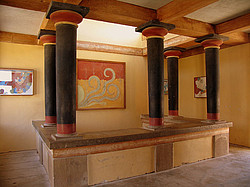
The day after the conference sessions (Wednesday, September 18, 2024) the following excursion will be organized:
1) Archaeological site of Knossos in Heraklion, and
2) Archaeological museum in the city of Heraklion
ARCHAEOLOGICAL SITE OF KNOSSOS
Knossos is the site of the most important and better known palace of Minoan civilization and is a "must see" during your vacation in Crete. According to tradition, it was the seat of the legendary king Minos. The Palace is also connected with thrilling legends, such as the myth of the Labyrinth with the Minotaur and the story of Daedalus and Icarus. The site was continuously inhabited from the Neolithic period (7000- 3000 B.C.) until Roman times.
After its partial destruction in 1450 B.C., Knossos was settled by Mycenaeans from the Greek Mainland. The city flourished again during the Hellenistic period in 67 B.C. It was captured by the Roman Quintus Caecilius Metelus Creticus. Knossos was discovered in 1878 by Minos Kalokairinos.
Arthur Evans conducted systematic excavations at the site between 1900 and 1931, bringing to light the palace, a large section of the Minoan city, and the cemeteries. The restoration of the palace to its present form was carried out by Arthur Evans. The interventions were mostly imposed by the need to preserve the monuments uncovered.
ARCHAEOLOGICAL MUSEUM OF CRETE
History is very much alive in the old town of Heraklion, just like in most Greek cities.From the old Venetian Harbour, the August 25th Str., leads to the old town's centre. The central square while surrounded by cafes, stores and restaurants, is dominated by the fountain of the Lions, built by Morozini the venetian governor in 1628. The Town Hall, is today housed in the Venetian Loggia, a building from the same era and next to it, the plateau and the cathedral of Agios Titos an exceptional monument from the Byzantine era.From the central square the street of the "Central Market" ends at "Kornarou Square" with the coffee house, housed at "Koubes" a Turkish fountain and next to it the "Bembo fountain" built by a Venetian nobleman. To the left "Averof Str." leads to "Eleftherias sq." ,
Heraklion's main square where the Archaeological museum stands and to the right 'Kyrillou Loukareos Str" leads to Agios Minas cathedral and Agia Aikaterini Museum. The archaeological museum is considered to be one of the most famous museums all over Europre and definately worths a visit. The museum brings together archaeological finds from all over Crete, covering over 5500 years of the island''s history. Pride of place is given to the treasures of Minoan civilisation, the entire historical course of which can thus be appreciated. Justly regarded as the home of Minoan civilisation par excellence, the museum houses the most important collection of Minoan antiquities the world over.
All around the old part of the city, visitors can walk following the Venetian walls that meet at the old port and "Koules", the fortress that dominates the old harbour of the city.of Minoan antiquities the world over.
